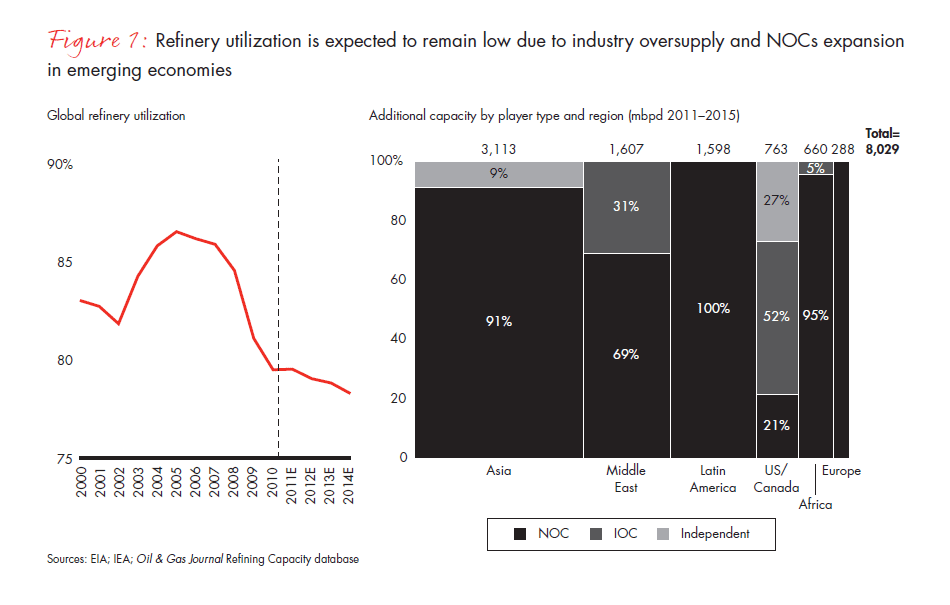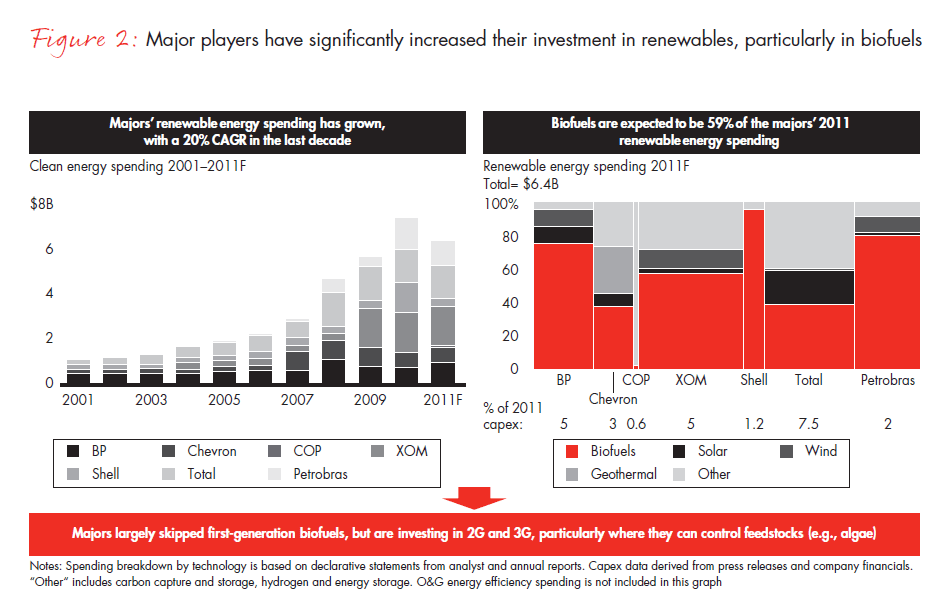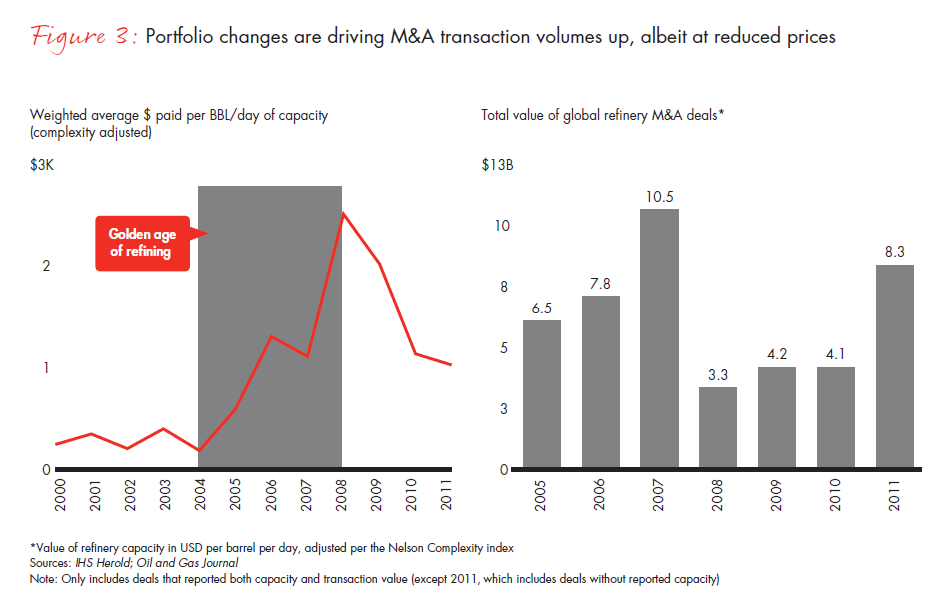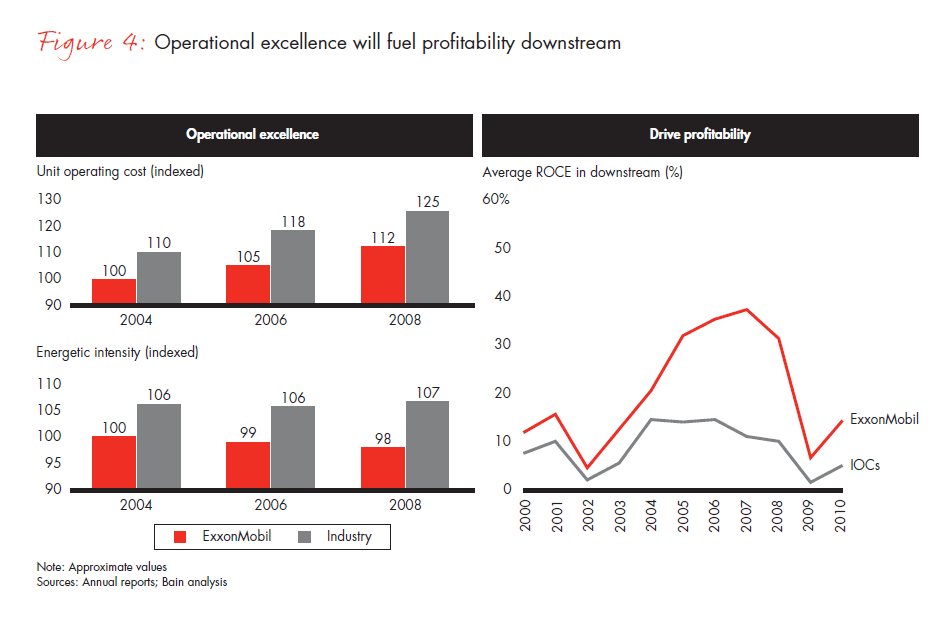Brief
As the center of gravity in the global refining industry shifts away from developed nations—especially the US—and toward emerging countries, companies throughout the oil and gas industry will need to rethink their approach to refining. Gasoline and diesel prices, long dependent on demand in developed nations, now fluctuate with developing nations’ soaring thirst for crude oil and fuels. The long-standing link between global crude prices, US gasoline prices and Gulf Coast marginal refining economics has been broken. The forces driving these changes are also creating an increasingly unattractive refining industry structure. Hyper oil prices and environmental costs are pressuring margins, which could lead to more refining asset restructurings and sales, or even bankruptcies such as the one that shuttered Petroplus Holdings, once Europe’s leading refiner, in January 2012. And gasoline demand in the US, which declined with the sluggish economy, faces further weakening as more hybrids and electric vehicles enter the market and biofuels become more competitive. Yet despite excess current industry supply and low margins, national oil companies (NOCs) continue to build out their refining capacity.
What does this mean for the industry and for individual companies trying to compete? Particularly in developed economies, the outlook for recovery is limited. As demand for petroleum-based refined motor fuels drops, companies will inevitably seek to reduce capacity. However, demand will likely drop even faster than supply, so total excess capacity will continue to increase and utilization will decline for the foreseeable future. The global refining industry will continue to experience cyclicality, but with the ups and downs increasingly dictated by the overall global economy, global crude markets and major refinery disruptions (caused by hurricanes and wars, for example).
Despite the turmoil, certain regional and global dynamics offer a potential upside. For example, refiners in the US Midwest currently benefit from the surge in shale oil. Due to inadequate takeaway infrastructure, this oil currently trades at a discount compared with world market crude prices and thus is buoying margins in the region. Also, refiners along the US’s Gulf Coast could benefit if refineries in the Northeast curtail operations due to excess capacity in the Atlantic market. Gulf Coast refineries would benefit even more if the Keystone pipeline, which would carry crude from Canada’s oil sands, is built. And, of course, the economics of biofuels and the pace at which hybrid and electric vehicles enter the market will also affect refiners.
Most of the upside will come from companies taking matters into their own hands. A sweeping restructuring of the refining industry is underway, affecting all types of companies and stimulating M&A activity. As a result, international oil companies (IOCs), independents and NOCs need to think differently about how and where they invest—and when to divest.
All of these companies will need to adjust to shifts in refining trends, but in general, IOCs face the most complex mix of risks and opportunities. As they think about how they can win, they can focus on three important questions: First, how can we benefit from the growing activity in emerging economies? Second, what is the right asset and investment portfolio? Third, how can we achieve world-class operational excellence?
How can we benefit from the growing activity in emerging economies?
The developing world—Asia in particular—will increasingly determine global fuels demand, causing much of the shift in the refining industry. OPEC estimates that between 2015 and 2020 demand for liquid fuels in the Asia-Pacific region will grow at 2% annually, while in North America and Europe, demand may decline slightly. IOCs can reposition themselves to take advantage of the new centers of demand.
While demand is shifting, so is supply—in somewhat less logical ways. Despite current industry supply excess, NOCs continue to add capacity, primarily in developing countries (see Figure 1). In “demand-rich” countries, NOCs seek to gain market share in fast-growing domestic markets. In oil-rich countries, NOCs want to promote the socioeconomic development of their home countries. Building out refining capacity adds value (and margin) to the crude oil produced there.

As NOCs build out their refining capacity in both oil-rich and demand-rich countries, many have explored partnerships with IOCs to benefit from their managerial and operational expertise, capital investment experience and access to global markets. Partnering with IOCs also helps NOCs promote integration downstream into lubricants and petrochemicals. This makes sense from a country standpoint because it helps limit imports, generates jobs, increases labor qualification and grows exports—all of which contribute to GDP.
These cross-border partnerships also offer potential benefits for IOCs, who might otherwise be locked out of the NOCs’ domestic markets. For example, in 2005 Saudi Aramco and Japan’s Sumitomo Chemical partnered to create Saudi-based Petro Rabigh, a joint venture (JV) in refining and petrochemical production. The $10 billion investment upgraded the existing refinery at Rabigh and added new petrochemical production facilities. Petro Rabigh went public in 2008, with each partner holding a 37.5% stake and the remaining 25% traded on the Tadawul, Saudi Arabia’s stock exchange. The venture is off to a good start: In 2011, the energysector publication Platts ranked it second on its list of fastest-growing companies, with a compound growth rate of 167.5%.
In 2008, Saudi Aramco partnered again, this time in a $12 billion JV with Total, to form the Saudi-based Saudi Aramco Total Refining and Petrochemical Co. (SATORP).
The JV’s refinery is expected to be up and running by the start of 2013 and will produce diesel, jet fuel, gasoline and petrochemicals.
In another joint venture, ExxonMobil China (25%), Saudi Aramco (25%) and Sinopec’s Fujian Petrochemical Company (50%) partnered in 2009 to invest $4.5 billion to expand the Fujian refinery at Quanzhou and add a new petrochemical complex.
These joint ventures between national and private international oil companies can succeed, but they require careful planning and dialog up front to ensure that the partners align their objectives.
In general, successful alliances are built on three key principles: First, they require a clear strategy, agreed upon by all partners. This means that the vision, rationale, incentives (including subsidies and tax exemptions) and scope of the alliance are clearly defined and the sources of value and success metrics are mutually decided. In many cases IOC-NOC joint ventures are better positioned to obtain government subsidies, including import tariff exceptions, beneficial financing and favorable tax terms, than an IOC might receive on its own.
Second, successful joint ventures are effective at making decisions. Management of the new entity must agree on critical decisions up front and ensure that roles and decision rights are clearly defined.
Third, the best JVs recognize that well-defined key processes and metrics support efficient operations, and they embed these in the JV design and organization from day one.
While all of the above are key factors in designing and maintaining a successful JV, not all NOCs are created equally nor focused on the same goals. For example, creating shareholder value may be secondary to protecting national markets or acquiring partner IP. It’s important to understand an individual NOC’s unique context, motivation and capabilities before entering into a partnership. The latter can be a particular challenge during the due diligence period, since NOCs may not have been independently audited or have documented accounts of their capabilities.
Getting approval for a JV with a NOC partner can also be complex, lengthy and ultimately reduce the value of the opportunity. A lack of clarity over company ownership, relevant stakeholders and decision-making authority can not only slow deal approval, but also threaten the long-term success of the partnership.
In addition to new refining capacity, changing crude and product flows have created the need for new distribution infrastructure and have opened significant trading opportunities. Given the nature of many of these new markets, in terms of size, competitive dynamics and the role of local governments, select NOCs have an advantage when it comes to building or acquiring storage and distribution infrastructure. For example, ENOC (Emirates National Oil Co.) has actively built a network of terminals in Singapore, South Korea, Djibouti and Morocco in less than 10 years.
Also, although historically trading has been dominated by IOCs and trading houses, many NOCs and independent refiners are becoming more sophisticated and gaining significant ground in global trading. For example, Petrobras opened a trading desk in Houston, Texas, in the late 2000s; Reliance is leasing storage capacity in the Caribbean to export gasoline from its Indian refineries and trade; and Valero bought the Pembroke refinery in the UK with the explicit aim, among others, of being more active in the Atlantic market.
What is the right asset portfolio?
In addition to partnering with NOCs in emerging economies, IOCs can also benefit from adapting their portfolios and investments, with the biggest wins likely from four key areas: increasing production of diesel (especially low-sulfur) and other attractive products (depending on the market), investing in high-complexity processing units, exploring select second- and third-generation biofuels and divesting structurally disadvantaged capacity.
Cleaner diesel, and more of it, is the order of the day. Not only has diesel long been the transportation fuel of choice in Europe, now it is becoming the preferred fuel in China and elsewhere in Asia. To address this burgeoning demand, IOCs are adding hydrotreaters and hydrocrackers at refineries from Malaysia (Shell) to Indiana (BP) to Texas (ExxonMobil) to California (ConocoPhillips) in an effort to produce lower-sulfur diesel.
In select markets, additional investments in products such as lubricants and petrochemicals may also be attractive. For example, in 2012 industry leader Exxon-Mobil will complete the expansion of a new petrochemical plant in Singapore. In September last year, ExxonMobil Chemical announced the expansion of the Baytown, Texas, chemical and refining complex, with plans to produce up to 50,000 tons per year of metallocene polyalphaolefin (mPAO). In December 2011, Chevron said it was considering building an ethane cracker and ethylene derivatives facility at one of its Gulf Coast refineries. In November, Total launched construction of a lubricant-blending plant in Tianjin, China. In August 2011, Royal Dutch Shell started operations of its first lubricant technology center in Zhuhai, China, and later that year CEO Peter Voser announced Qatari government approval for a JV between Shell and Qatar Petroleum to build one of the world’s biggest monoethylene glycol plants in Qatar. In April 2011 Petrobras announced Braskem as the strategic partner for the development of several petrochemical streams in its Comperj integrated refining and petrochemical complex in Rio de Janeiro state.
And of course there is the question of biofuels. Traditionally IOCs have viewed alternative fuels as threats— alternatives to traditional gasoline and diesel. However, not all sources of alternatives are disruptive to IOCs’ refining portfolios. For example, given the threat of electric or hydrogen-powered vehicles, or corn-based ethanol—which is incompatible with the existing refining and transportation systems—other biofuels may be quite attractive. For example, renewable diesel (derived from animal fats) is a “drop in” ready fuel that can be produced at oil refineries through hydrogenation. Pyrolysis oil, essentially synthetic crude oil, is chemically derived from biomass and like crude oil is used as feedstock in conventional refining. As another example, biobutanol has a production process similar to ethanol but is more compatible with downstream infrastructure.
Smart IOCs recognize that biofuels aren’t going away and know that strategic investment in this area is key (see Figure 2). Across the industry companies are investing in both conventional and next-generation biofuels, from second-generation ethanol to algae. Compared with other forms of alternative energy, biofuels can be a positive for refining companies, helping to perpetuate the internal combustion engine and in several cases also sharing the same logistics and distribution infrastructure as gasoline and diesel.

The industry’s leaders are also actively pruning their portfolios. For example, Shell has completed or intends sales in the UK, Africa, Scandinavia, Greece and New Zealand. ConocoPhillips announced in March 2011 that it would put up for sale about $10 billion of downstream assets over the following two years. Total announced the repurposing of its Dunkirk refinery to other industrial uses (idle since September 2009 because of the recession), and targeted about a 20% reduction of its global refining capacity between 2007 and 2011. In March of 2011, Chevron agreed to sell multiple downstream assets in the UK and Ireland for $730 million, plus $1 billion for inventories.
Portfolio management is resulting in a new wave of M&A across the refining industry, in terms of both number of deals and total value (see Figure 3). Motivated buyers seem to be influenced by a combination of entering during a down cycle and the opportunity to improve operations. For example, change of ownership makes it easier to renegotiate contracts (with suppliers, local municipalities, contractors and employees). A broader portfolio of refineries (and storage and logistics assets potentially utilized for trading) also gives operators greater flexibility.

Thinking about which refineries to keep and invest in is a question not only of location and volume but also of complexity. As seen in one US Gulf Coast example of coking versus cracking, the coking refinery commands significantly higher margins because of the higher percentage of high-value products combined with the ability to use lower-cost crude. In 2011, Maya an average coking refinery, enjoyed margins of $4 per barrel versus a negative $1 per barrel for its cracking refinery processing. Other considerations include regional market attractiveness, the role of an individual refinery within a broader network and adjacent businesses whose profitability hinges on a particular refinery (for example, lubricants).
How can we achieve world-class operational excellence?
As the refining industry tries to cope with oversupply, shifting cyclicality and low average margins, operational excellence and a continuous improvement mindset and capability will separate the leaders from the rest of the pack. Companies that successfully lower costs and energetically pursue continuous improvement can benefit with significantly higher returns on capital employed—sometimes by as much as three times (see Figure 4).

Sustained cost transformation, while complex and sometimes painful, can reduce total costs by about 15% and can actually accelerate revenue growth. How? Especially in a commodities business like refining, margins are critical. Companies that have a leading cost position have significantly more money to invest in new assets and new markets—critical for IOCs hoping to compete in the new refining world. Sustained cost transformation isn’t about risky spending cuts, but about a focus on core strengths and efficient delivery.
Even companies with better-than-average cost positions have significant opportunities for improvement. In our experience, most value is discovered or recovered using five key performance improvement levers.
The first involves increasing the output of finished products, largely through higher utilization and higher throughput.
Next is an increase in the yield, which serves to reduce crude and overall feedstock costs.
Third, most companies can also reduce operational costs, often by lowering fixed costs through increased labor productivity and reduced maintenance costs.
Fourth, companies can usually reduce their sourcing costs by reassessing their sourcing strategy, including developing alternative suppliers, renegotiating contracts and investigating options for developing substitute products.
Finally, even the best companies can reduce support costs, including overhead and noncritical services. Typical opportunities include aggregating support services across refineries and outsourcing some services. In addition, we often find that there are areas where service levels are higher than what is required, as well as services that can be eliminated.
The rise of the NOCs and the shifting of demand growth to emerging economies pose challenges for refiners—but also new opportunities. Leading refiners are tapping into some of these opportunities by forming partnerships with well-positioned NOCs, sharing expertise in exchange for access. At the same time, they are carefully assessing the potential of their existing refining and trading assets, trimming their portfolios when doing so will improve the balance in the organization, and selectively expanding their participation in biofuels. In such a rapidly changing environment, operational excellence is more important than ever. Despite increased industry challenges, refinery executives who navigate this period wisely can position their organizations to benefit from these shifting global trends and win.
José de Sá is a partner in the Bain's Rio de Janeiro office and a leader in the firm's Oil and Gas practice.
Independents
Independents pursue value by capturing opportunities. In the 1990s and early 2000s, companies like Tesoro and Valero bought US refineries at the bottom of the last cycle and added conversion capacity, reaping large rewards when margins bounced back. Independents can show similar agility during the current market environment by selectively acquiring assets disposed of by IOCs, buying out smaller independents and investing in selective expansion. In addition, success requires a relentless focus on cost, increased operational flexibility and improved supply and trading capabilities.
One example of selective expansion: Tesoro’s plan to increase the capacity of its Salt Lake City refinery to take advantage of crude price differentials. Increases in liquids production from shale have outpaced the infrastructure to transport these crudes to market, leading to price discounts and refiner opportunity in the affected areas. Discounts can be so large, such as in the case of Tesoro’s Salt Lake City expansion, that they expect a two-year payback for their investment.
With respect to reducing costs and increasing operational flexibility, we still see a lot of potential for independent refiners. For example, in most cases, independents have not fully integrated the refineries they bought in the 1990s and 2000s, leaving significant opportunities for streamlining support functions, increasing purchasing power and capturing network supply and trading advantages. In addition, operational costs within refineries can be decreased by transferring best practices from one refinery to another.
NOCs
NOCs may benefit most from shifts in the refining industry, but to maximize profits and avoid massive cost overruns, they will have to improve managerial, operational and capital excellence. Many NOCs have already made smart decisions about tactically delaying new capacity given current industry supply, but NOCs still can significantly improve their supply chain management capabilities. NOCs seeking to partner with IOCs can undoubtedly move down the learning curve faster, but what types of collaboration will benefit them most?
Unlike IOCs and independents, NOCs are also concerned about how to use investments in downstream to generate jobs and wealth for their domestic economies. Can they do this best by focusing solely on traditional refining, or should they branch out into lubricants, petrochemicals, biofuels, marketing and trading or other options?



